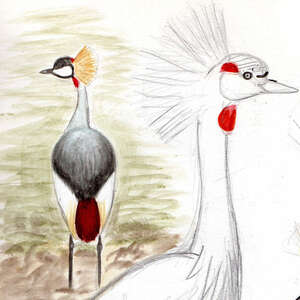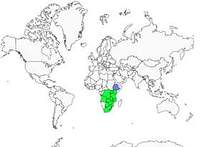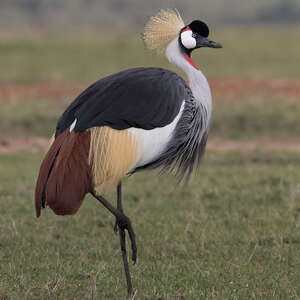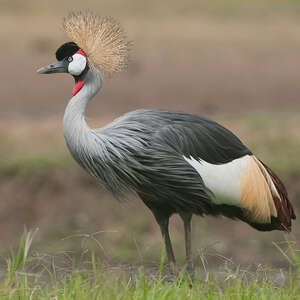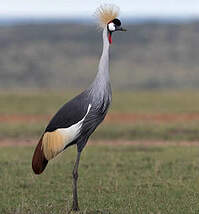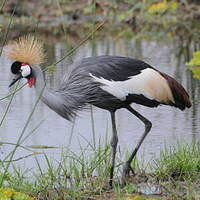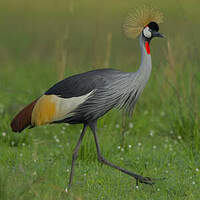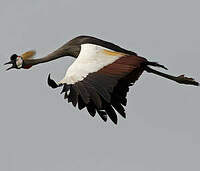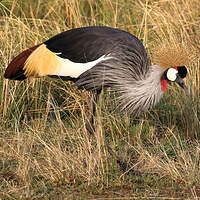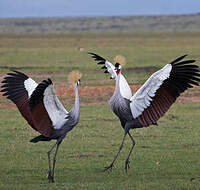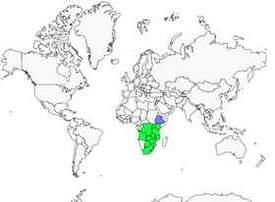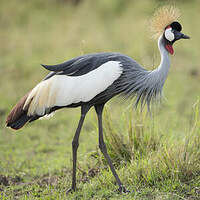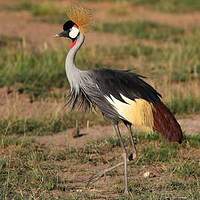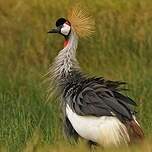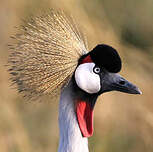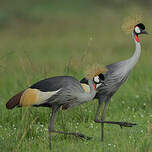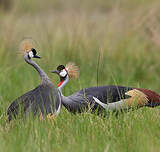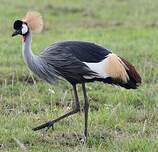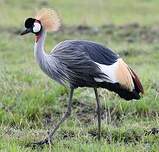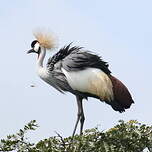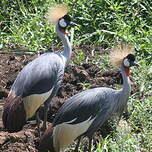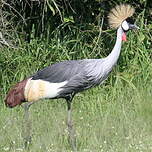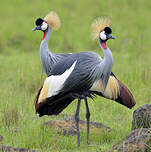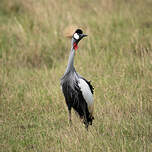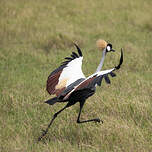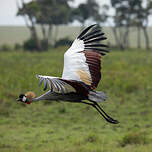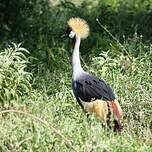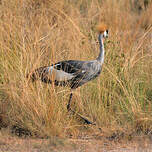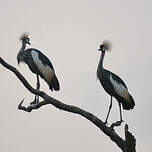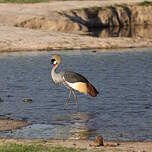Grey Crowned Crane
Balearica regulorum - Grue royale
Identification
The sexes are identical.
The plumage of the adult's body is a deep grey that turns lighter on the neck, which gives the species its English name of Grey Crowned Crane (Grey Crowned Crane) in contrast to Black Crowned Crane, with which it is often confused and which has a dark grey to black body and neck.
As with the crowned crane, the upper and lower coverlets are white on both sides of the wing, with a yellow spot on the upper side on the inner large coverings. The secondaries are brown while the primaries are black.
As with its consort, the forehead and front of the crown, very domed, are black, while the back of the crown is a crown of long, erect gold-colored feathers.
But unlike the crowned crane, the cheeks, bare, are white, only marked with a red spot at the top, behind the eye.
The red caruncle the Royal Crane wears on its chin is well developed, much more than the crowned crane where it is barely visible.
The iris is grey-blue, the bill is long, strong and straight. It is dark grey. The legs are grey.
The immatures look like adults, only paler. Their eyes are brown.
Subspecific information 2 subspecies
- Balearica regulorum regulorum (s Angola and n Namibia to Zimbabwe and e South Africa)
- Balearica regulorum gibbericeps (s Uganda and Kenya to n Zimbabwe and n Mozambique)
Foreign names
- Grue royale,
- Grulla coronada cuelligrís,
- grou-coroado-austral,
- Grauhals-Kronenkranich,
- szürkenyakú koronásdaru,
- Grijze Kroonkraanvogel,
- Gru coronata grigia,
- grå krontrana,
- Gråkrontrane,
- žurav kráľovský,
- jeřáb královský,
- Grå Krontrane,
- etelänkruunukurki,
- Mahem (Mahemkraanvoël),
- grua coronada collgrisa,
- koronnik szary,
- Восточный венценосный журавль,
- ホオジロカンムリヅル,
- 灰冕鹤,
- grå krontrana,
- 灰冠鶴〔東非冕鶴〕,
Voice song and call
Habitat
Behaviour character trait
Grey Crowned Cranes live in pairs, usually within a group of twenty individuals. The roosting groups, in the tall grasses along rivers as well as in trees, can count up to 200 individuals. Just like its cousin the Black Crowned Crane, it is likely that the couple of Grey Crowned Cranes is established for life. The nuptial parade includes bows with mutual preening of feathers, big jumps, and small races, all punctuated with cries, head bowed.
Flight
Dietfeeding habits
Reproduction nesting
Geographic range
The Grey Crowned Crane, like the Grey Crowned Crane, is a sub-Saharan species. Its distribution area is separated from that of the Grey Crowned Crane (see this species). The Grey Crowned Crane is present throughout South Africa, up to the DRC in the north, and in East Africa up to Uganda and Kenya. It is absent from southeastern Tanzania.
Threats - protection
IUCN conservation status
concern
in the Wild
threatened
evaluated
The Grey Crowned Crane is endangered due to the loss and degradation of its feeding zones. Responsible for this are drainage of wetlands, overgrazing, usage of pesticides, uncontrolled burning during reproduction season, and cultivation of arable land. The construction of dams for electricity production, as well as the extraction of groundwater, resulting in changes to the hydrologic regime, all have an impact too.
Moreover, the illegal trafficking of live animals, as well as hunting, is also not insignificant, especially since the Grey Crowned Crane, due to the reduction of its habitat, is being driven to live closer to settlements. Research has proven, for example, that many Grey Crowned Cranes are poisoned annually in Kenya, either as retaliation or to protect sowing from predation.
Finally, bird mortality due to electrocution and collisions with high voltage lines is a serious threat in Uganda, South Africa and Tanzania, and is likely to worsen.
Due to these reasons, and its population having greatly decreased, the Grey Crowned Crane is classified Endangered.
Sources of information
- IOC World Bird List (v15.1), Gill, F and D Donsker (Eds). 2025-12-07.
- BirdLife International, BirdLife International
- IUCN Red List of Threatened species,
Other sources of interest
 Specification sheet created on
29/07/2023 by Catherine et Bernard Lanneluc
Specification sheet created on
29/07/2023 by Catherine et Bernard LannelucTranslation by AI Oiseaux.net
© 1996-2026 Oiseaux.net
- Accipitriformes
- Aegotheliformes
- Anseriformes
- Apodiformes
- Apterygiformes
- Bucerotiformes
- Caprimulgiformes
- Cariamiformes
- Casuariiformes
- Charadriiformes
- Ciconiiformes
- Coliiformes
- Columbiformes
- Coraciiformes
- Cuculiformes
- Eurypygiformes
- Falconiformes
- Galliformes
- Gaviiformes
- Gruiformes
- Leptosomiformes
- Mesitornithiformes
- Musophagiformes
- Nyctibiiformes
- Opisthocomiformes
- Otidiformes
- Passeriformes
- Pelecaniformes
- Phaethontiformes
- Phoenicopteriformes
- Piciformes
- Podargiformes
- Podicipediformes
- Procellariiformes
- Psittaciformes
- Pterocliformes
- Rheiformes
- Sphenisciformes
- Steatornithiformes
- Strigiformes
- Struthioniformes
- Suliformes
- Tinamiformes
- Trogoniformes

